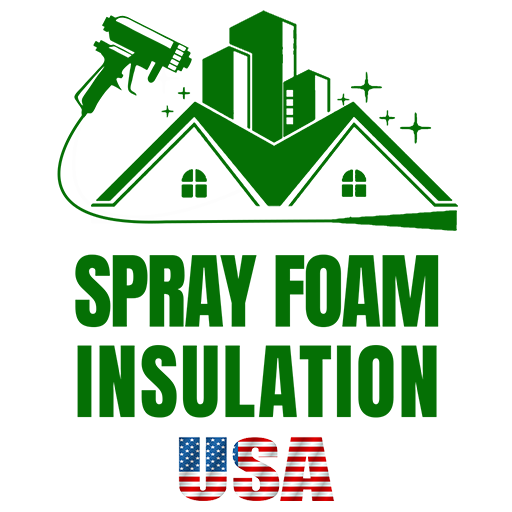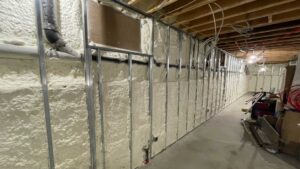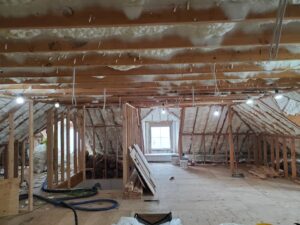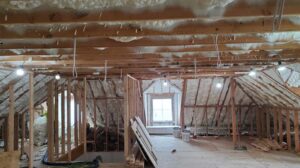Introduction
Insulated roofs are a game-changer for anyone looking to enhance their home’s energy efficiency and comfort. Quick to install and offering both immediate and long-term benefits, these roofing solutions are a top choice for savvy homeowners. Insulated roof panels not only lower heating and cooling costs but also improve your living environment by maintaining a stable indoor temperature.
Insulated roofs work by minimizing heat transfer between the outdoors and the indoor space, making them particularly beneficial for regions with extreme weather conditions. Whether it’s blazing hot summers or freezing winters, an insulated roof helps keep the indoor climate comfortable without over-relying on HVAC systems. This reduction in energy consumption directly translates to lower utility bills.
Moreover, these roofing systems are DIY-friendly, empowering homeowners with a bit of handy skills to install their own systems efficiently. Businesses too can reap the benefits, enjoying reduced operational costs and enhanced green credentials. Listed below, delve deeper into how insulated roofs can be a transformative investment for both homes and businesses.

Understanding Insulated Roofs
When considering an insulated roof, understanding the types, materials, and thermal efficiency is crucial. This knowledge helps in choosing the right solution for your specific needs. Let’s break down these elements:
Types of Insulated Roofs
Insulated roofs come in various types, each suited to different building requirements and climates:
- Insulated Metal Roof Panels (IMPs): These are pre-manufactured panels consisting of metal skins and an insulating foam core. They are known for quick installation and high thermal performance.
- Polystyrene Core Insulated Panels: Common in residential settings, these panels are lightweight and provide excellent insulation with a focus on reducing heat transfer.
- Fiberglass and Cellulose Panels: These materials are often used in attic roof insulation for their affordability and effectiveness in temperature regulation.
Materials Used in Insulated Roofs
The choice of material impacts the roof’s insulation ability, durability, and cost:
- Polyisocyanurate Foam: Often used in IMPs, this foam offers high R-values, making it highly effective for thermal resistance.
- Polystyrene: This is a lighter option used in some insulated panel systems, suitable for less demanding thermal efficiency requirements.
- Fiberglass and Cellulose: These materials are eco-friendly and are primarily used in loose-fill or batts for attic insulation.
Thermal Efficiency
The thermal efficiency of an insulated roof is measured by its ability to resist heat flow, known as the R-value. Higher R-values indicate better insulation properties. For example, continuously poured-in-place polyisocyanurate foam in IMPs can achieve high R-values, ensuring excellent thermal performance that meets diverse building codes and climate demands.
Energy Efficiency: Insulated roofs play a significant role in reducing energy consumption by maintaining stable indoor temperatures, thus requiring less heating in winter and cooling in summer. This efficiency not only helps in cutting down utility bills but also contributes to a more sustainable living environment.
Understanding these aspects of insulated roofs helps in making informed decisions about your roofing needs, whether for a new installation or upgrading an existing one. With the right insulated roof, you can enhance your home’s energy efficiency, comfort, and overall value.
In the next section, we will explore how to evaluate your specific needs to choose the most suitable insulated roof panels for your home or business.
Evaluating Your Needs
Before diving into the installation of an insulated roof, it’s crucial to assess your specific needs to ensure you choose the right materials and methods. Here are some key factors to consider:
Energy Savings
The primary reason to install an insulated roof is to save on energy costs. Insulation helps to keep your home warmer in the winter and cooler in the summer, reducing the need for heating and air conditioning. This can lead to significant reductions in your energy bills. According to RAY-CORE, their SIPs can decrease utility bills by 60% or more, showcasing the potential savings.
Utility Bills
Consider your current utility bills: Are they higher than you’d like? An insulated roof can be a game-changer. By adding a layer of insulation, you’re essentially adding a barrier that regulates your home’s temperature, leading to lower heating and cooling costs. The investment in insulation might seem substantial initially, but the reduction in utility bills will continue for years, making it a cost-effective solution in the long run.
Roof Slope
The slope of your roof can also influence the type of insulated roof panels suitable for your home. Different slopes may require different installation methods and insulation types. For example, a steep slope might shed water and snow more easily, allowing for different insulation considerations than a flat roof, which may need to handle greater loads and water pooling.
When choosing insulation, consider:
– Flat roofs: These often require more robust waterproofing and can benefit from rigid foam panels that provide both insulation and structural support.
– Steep roofs: These might use lighter insulation options, such as batts or blankets, that are easier to install under the roofing material.
By carefully evaluating these aspects — energy savings, utility bills, and roof slope — you can make an informed decision on the best insulated roof panels for your needs. This not only helps in cutting down utility bills but also contributes to a more sustainable living environment.
In the next section, we will guide you through choosing the right insulated roof panels based on these evaluations and other important factors.
Choosing the Right Insulated Roof Panels
When it comes to selecting the right insulated roof panels for your home, understanding the different materials available is crucial. Here, we’ll discuss three popular types: Glass wool, Roof insulation boards, and Polyisocyanurate foam. Each has unique properties that cater to different roofing needs.
Glass Wool
Glass wool is made from fibrous materials combined with a binder and formed into panels and rolls. It’s known for its excellent thermal and sound insulation properties. Glass wool is lightweight, making it easy to handle and install. It’s particularly effective in climates where both heating and cooling are necessary, as it helps maintain a comfortable indoor temperature year-round.
Roof Insulation Boards
Roof insulation boards are rigid panels used for insulating roofs and walls. Commonly made from materials like polystyrene or polyurethane, these boards are excellent at reducing heat transfer. They are versatile, available in various thicknesses and densities to meet specific insulation requirements. This type of insulation is ideal for flat roofs or where a higher load-bearing capacity is needed.
Polyisocyanurate Foam
Polyisocyanurate foam, often referred to as PIR, is among the most thermally efficient insulation materials available. It features a high R-value, which measures an insulation’s ability to resist heat flow. The higher the R-value, the better the insulation performance. PIR is particularly beneficial in areas with extreme temperature variations. It also boasts a low moisture absorption rate, making it suitable for humid climates.
When choosing the right insulated roof panels, consider factors such as your local climate, the specific needs of your building, and sustainability goals. For instance, if you’re in a colder region, panels with higher R-values like Polyisocyanurate foam might be the best choice. Conversely, in milder climates, Glass wool could provide sufficient insulation while being cost-effective.
The right insulated roof panels not only enhance your home’s energy efficiency but also contribute to a comfortable living environment. In the next section, we’ll walk you through the installation process to ensure you get the most out of your insulated roofing system.
Installation Process
Installing your own insulated roof can be a rewarding DIY project that enhances your home’s energy efficiency and comfort. Here’s a straightforward guide to help you through the preparation, measuring, cutting, and securing of insulated roof panels.
Preparation
Before you begin, it’s crucial to ensure that your roof structure is sound and capable of supporting the new insulated panels. Check for any signs of damage or wear, such as rot or structural weakness, and make necessary repairs.
Tools and Materials Needed:
– Safety gear (gloves, goggles, hard hat)
– Tape measure
– Chalk line
– Utility knife
– Drill with driver bits
– Screws and fasteners
– Sealant and caulking gun
Clear the roof surface of any debris, dust, or existing roofing materials if you’re replacing the roof. Make sure the surface is dry and level.
Measuring
Accurate measurements are key to a successful installation. Measure the length and width of your roof to determine how many panels you will need. Always add about 10% extra for waste and cutting mistakes.
Use a chalk line to mark where each panel will go. This will serve as a guide during installation and ensure that your panels are aligned correctly.
Cutting
Insulated roof panels typically need to be cut to fit specific areas of your roof, especially around edges and corners. Measure twice and cut once to ensure accuracy. Use a sharp utility knife or a circular saw with a blade suitable for cutting insulation material.
Tip: Make shallow and multiple passes with the knife to avoid compressing the insulation, which can reduce its effectiveness.
Securing
Start at one edge of the roof and work your way across. Place the first panel according to your chalk line guides and check for alignment. Secure the panel to the roof structure using screws and fasteners. It’s important to follow the manufacturer’s recommendations for spacing and depth.
Use a drill with a driver bit that matches your screws. Ensure each panel is flush against the roof deck and that there are no gaps between panels. Gaps can be filled with insulation strips or sealant to prevent thermal bridging.
Apply sealant along the edges of each panel to create a weather-tight seal. This prevents moisture from penetrating the roof and compromising the insulation.
Repeat the process for each panel, ensuring tight joints and secure attachments.
Final Checks
Once all panels are installed, inspect the entire roof to ensure every panel is securely fastened and sealed. Check for any potential thermal bridges or gaps and address them with additional sealant or insulation strips.
This installation process not only secures your insulated roof panels but also ensures they perform effectively, keeping your home warm in winter and cool in summer. Next, we’ll cover the essential maintenance and care tips to keep your insulated roof in top condition for years to come.
Maintenance and Care
Once your insulated roof is installed, proper maintenance is crucial to ensure its longevity and effectiveness. Here’s a straightforward guide on how to inspect, clean, and repair your insulated roof panels.
Inspection
Regular inspections are key to maintaining the health of your insulated roof. It’s recommended to inspect your roof at least twice a year—before and after the harsh weather seasons. Look for any signs of damage such as:
- Dents or punctures in the panels
- Loose or missing fasteners which can compromise the roof’s integrity
- Gaps or inconsistencies in the sealant, as these can lead to thermal bridging
If you’re not comfortable doing the inspection yourself, consider hiring a professional. They can spot issues that might not be obvious to the untrained eye.
Cleaning
Keeping your insulated roof clean will not only extend its life but also maintain its aesthetic value and effectiveness in insulation. Here’s how to clean your roof safely and effectively:
- Remove Debris: Use a soft broom or a leaf blower to clear off leaves, twigs, and other debris accumulated on the roof.
- Wash the Roof: Gently wash the roof panels using a low-pressure hose and a mild soap solution. Avoid high-pressure washers as they can damage the panels.
- Check for Mildew: In humid climates, check for signs of mildew or mold. If present, use a solution of mild detergent and water to clean it off.
Always ensure you’re using non-abrasive tools and cleaners to prevent scratching or damaging the panels.
Damage Repair
If you find minor damage during your inspections, addressing it promptly can prevent more significant issues later. Here are some tips for simple repairs:
- Sealant Gaps: If you discover small gaps in the sealant, reapply a compatible sealant to prevent air leaks and water ingress.
- Loose Fasteners: Tighten any loose screws and replace missing ones to ensure all panels are securely attached.
- Minor Punctures: For small punctures or tears, use a sealant or a repair tape designed for metal roofs. Ensure the area is clean and dry before applying the repair material.
For more significant damage, it’s wise to contact a professional. They can assess whether a simple repair will suffice or if a panel replacement is necessary.
By following these straightforward maintenance and care steps, you can ensure your insulated roof remains effective and continues to provide energy savings and comfort. Up next, we’ll answer some frequently asked questions about insulated roofs to help you understand even more about their benefits and care.
Frequently Asked Questions about Insulated Roofs
What is the best type of insulation for a roof?
The best type of insulation for a roof depends on several factors including climate, budget, and specific building needs. Here are some common types:
- Fiberglass: This is widely used due to its affordability and ease of installation. It’s suitable for DIY projects but offers a lower R-value per inch.
- Cellulose: Made from recycled paper, eco-friendly, and has a higher R-value than fiberglass. Effective for blocking air leaks but can absorb moisture.
- Mineral Wool: Known for excellent fire resistance and moisture resistance. It is generally more expensive.
- Spray Foam: Provides high R-value and exceptional air sealing properties. Requires professional installation but is highly effective.
- Rigid Foam Board: Great for areas needing high moisture resistance. It has a high R-value but can be more challenging to install.
Each type has its benefits depending on your specific needs. For example, spray foam and rigid foam board are excellent in climates with extreme temperature variations due to their high R-values and moisture resistance.
Are insulated roof panels worth it?
Yes, insulated roof panels are definitely worth it. They offer several advantages:
- Energy Efficiency: They help maintain a stable indoor temperature, reducing the need for heating and cooling. This can lower your utility bills significantly.
- Quick Installation: Compared to traditional roofing methods, insulated panels are quicker to install, saving on labor costs.
- Durability: These panels are known for their strength and durability, often coming with long warranties.
- Eco-Friendly: Many insulated roof panels are made from recyclable materials, making them a greener choice.
Considering these benefits, the investment in insulated roof panels often pays off in the long run through energy savings and reduced maintenance costs.
What are the advantages of insulated roof?
Insulated roofs provide numerous advantages that make them a popular choice for both residential and commercial buildings:
- Improved Thermal Efficiency: Insulated roofs act as a barrier against heat transfer, keeping your home warmer in winter and cooler in summer.
- Cost Savings: By improving energy efficiency, insulated roofs reduce the cost of heating and cooling, which can lead to significant savings on energy bills.
- Enhanced Comfort: They help in maintaining a consistent indoor temperature, which enhances comfort inside the building.
- Noise Reduction: Insulated roofs can reduce the amount of noise that enters a building, making for a quieter and more peaceful environment.
- Increased Property Value: Buildings with insulated roofs often have higher market values due to their enhanced efficiency and comfort.
By choosing the right type of insulated roof, you can enjoy these benefits while also contributing to a more sustainable future. If you’re considering upgrading your roof, insulated panels are a robust option that can improve your home’s performance and comfort.
In the next section, we will explore the sustainability aspects of choosing insulated roofing solutions from Spray Foam Insulation USA, highlighting how they contribute to a greener and more energy-efficient home environment.
Conclusion
As we wrap up our discussion on insulated roofs, it’s crucial to highlight the sustainability efforts and commitments of Spray Foam Insulation USA. By opting for our insulated roofing solutions, not only do you enhance the energy efficiency of your home, but you also take a significant step towards supporting environmental sustainability.
Sustainability at the Core
At Spray Foam Insulation USA, we understand that every choice we make today affects our planet tomorrow. That’s why our insulated roof panels are designed with sustainability in mind. These panels help reduce energy consumption significantly, which in turn lowers greenhouse gas emissions. By keeping your home warmer in the winter and cooler in the summer, our insulated roofs reduce the need for excessive heating and cooling, conserving energy.
Moreover, the materials used in our insulated roofs are chosen for their durability and performance, ensuring that they last longer and reduce the need for frequent replacements. This longevity contributes to less waste and a lower environmental impact over the life of the roof.
Why Choose Spray Foam Insulation USA?
Choosing Spray Foam Insulation USA means partnering with a leader in energy-efficient and sustainable roofing solutions. Here are a few reasons why our insulated roofs stand out:
- Energy Efficiency: Our products are designed to maximize thermal efficiency, which can decrease your utility bills by a significant margin.
- Durability: We use high-quality materials that are built to last, ensuring that your investment continues to pay off for years to come.
- Sustainable Practices: We are committed to reducing our environmental footprint by using materials and processes that are eco-friendly and sustainable.
By installing an insulated roof from Spray Foam Insulation USA, you’re not just upgrading your home; you’re also making a choice that benefits the environment. It’s a proactive step towards reducing your carbon footprint and promoting a healthier planet.
Discover how you can make your home more energy-efficient with Spray Foam Insulation USA.
In conclusion, insulated roofs from Spray Foam Insulation USA offer more than just improved thermal efficiency and comfort. They represent a commitment to sustainability and environmental responsibility. As we continue to innovate and lead in the insulation industry, our focus remains on providing solutions that not only meet the needs of today but also contribute to a sustainable future. Choose Spray Foam Insulation USA for your next roofing project and join us in building a greener world.





